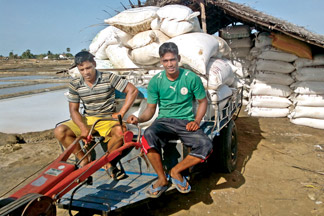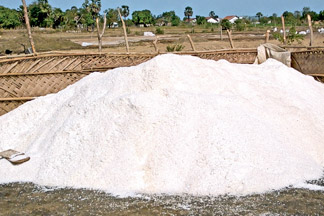Kinniya salt iodating factory will boost local economy - Divisional
Secretary
By Mohammed NAALIR
|

Kinniya Divisional Secretary
C. Krishnendran.
|
Plans are afoot to set up a salt iodating factory in Kinniya, with
the help of the Divi Neguma rural development program, Kinniya
Divisional Secretary (DS) C. Krishnendran said.
Sri Lanka is achieving self-sufficiency in salt production. A large
number of small salterns contribute indirectly to achieve this goal.
There is a necessity to improve the quality of production of these
salterns to meet national standards. Kinniya salt is below the required
standard, the Divisional Secretary said.

Salt packs are loaded to a landmaster

Harvested salt |
Salt production was introduced on a Samurdhi Concept to improve the
living standards of beneficiaries. A large number of people are engaged
in salt production as a lucrative venture.
The Divi Neguma project supports the industry by providing the
technology to enhance the quality of salt.
The price of salt produced by Kinniya farmers depends on the
opportunities for making. Kinniya salt is used to manufacture soap and
leather preservation.
It is not used for consumption. A higher price for salt can be
obtained only by improving the quality of salt, Krishnendran said.
Merely, engaging in salt production will not help to improve the
quality of salt. Farmers should improve their professional skills to
develop the industry, the Divisional Secretary said.
Kinniya Divisional Secretariat leases lands to low income families to
start salterns. From time to time the Samurdhi Authority provides
guidelines to farmers.
Divisional Secretary Krishnendran said that salt production is the
livelihood of over 300 families in Kinniya.Kinniya Divisional
Secretariat is issuing permits to freight salt from Kinniya to other
parts of the country. Certain people still use permits issued by the
Commissioner General of Essential Services to transport salt. Due to
this process the Divisional Secretariat is unable to exactly count how
many people are engaged in salt transportation.
If a salt iodating plant is set up a large amount of money can be
saved, Krishnendran said.
People in Kinniya are engaged in salt production for more than 20
years. People in the area started salterns and today it provides
livelihood to a large number of people, the Divisional Secretary said.
Besides Krishnendran said that the contribution of Pradeshiya Sabhas
is vital to protect the environment.
Meanwhile the Divisional Secretary said that paddy and salt
production should take place parallely. Each industry should not affect
other.
Kinniya Predashiya Sabh a Chairman S.L.M. Jawadullah we talked to
said salt and seashells are the main natural resources in Kinniya.
He said that the Kinniya Pradeshiya Sabha is taking steps to make use
of those resources.
It plans to set up a salt iodating plant. The 'Divi Neguma program of
the Economic Development Ministry has allocated funds for this purpose.
If this plant was set up over 1,000 direct and indirect employment
can be generated, Jawadullah said.
Salt farmers receive a low price for their production. They also face
immense difficulties to market their products.
The salt industry is years behind due to lack of opportunities for
marketing and owing to its low quality, he said.
Jawadullah said that he will obtain assistance of NGOs to improve the
professional skills and develop the industry.
N.M. Razick, said that he is engaged in salt production for nearly 10
years without help from anyone. Marketing is a major issue of salt
farmers.
Their income is low. One kilo of salt is purchased at Rs. 6. If Rs.
10 was offered the production cost can be covered.
He said that salt produced in Kinniya is transported to Puttalam for
iodating, packing and other purposes.
There is another saltern in Kachchakoditivu in Kinniya, an area of
over 150 acres. They also face problems in marketing
Salt farmers in Kinniya have called upon the Government to protect
the industry.
Salt is harvested in 15-20 days depending on the weather.
During the rainy season the harvest will decline, Razick said.Yunus
Junaideen, a salt farmer in the area said the manufacturer and buyer can
benefit from the Industry. He said that different prices are offered by
different purchasers. There is less demand for Kinniya salt. A 50
kilogram pack of salt ranges from Rs. 250 to Rs. 300. This is not
sufficient to pay wages of to labourers. There are several expenses in
the salt manufacturing process.
If the Government or other private sector institutions come forward
to purchase one kilo of salt at Rs. 10 it will be helpful to improve the
living standards of the farmers as well as the industry. A worker is
paid Rs. 1,000 per day and transporter is paid Rs. 20.
"When a kilo of iodated salt is Rs. 30 in the market, nobody is
willing to offer at least at Rs. 10 for our salt" Junaideen said.
The salt farmers in Kinniya supply over 400,000 packs of salt to the
market, he said. Each farmer can supply over 1,000 packs of salt.
Jailany Mohammad Farook said that the Samurdhi Authority constructed
a canal to irrigate salt fields in Kachchakoditivu. Each farmer has to
pay Rs. 1,600 to the Authority every year.
The salt farmers have formed a society to voice their concerns. Even
though the society makes certain welfare arrangements, financially it is
weak to purchase the entire production.
H. M. Muhammad Najaab, a salt farmer in Kinniya, said that his income
depends on the extent of the saltern. He operates a quarter acre saltern
and earns over Rs. 150,000. He is able to harvest nearly 400 packs of
salt every season. "There is no monopoly in the salt market", Najaab
said.Earlier a 50 kilo pack of salt was purchased at Rs. 700. Today the
price has dropped around Rs. 250 to Rs. 300. Our income is poor when
compared to the expenditure. Salt which was sold at Rs. 50,000 has
decreased to Rs. 25,000.
"We do not get the assistance of the Government or other welfare
organisations to improve the quality of salt and to market the product"
Najaab said.
"The Government should have a stipulated price for salt to protect
industry. The farmers incur losses due to price fluctuation.
The future of salt farmers depends on the support of the Government,
according to Najaab.
Muhammad Ismail Manaz, a salt farmer in Kinniya, who produces salt in
a quarter acre said that as a result of the drop in salt price the
income of farmer has been affected badly.
The rise in the price of kerosene oil has also affected the income of
the salt farmers, he said.Muhammad Hanifa Naseer, a salt farmer in
Munaichchenai, Kinniya said that from a over 50-acre saltern nearly
60,000 packs of salt is harvested every season. Salt from the area is
transported to Hambantota, Kandy, Colombo, Matale, Negombo and Kalmunai.
He said that a kilo of salt was sold at Rs. 10 to Rs. 12, due to the
increase in salt production. As a result the price of salt has declined.
The authorities should take steps to set up a sluice gate to divert
the excess water in the canal", he said. |

